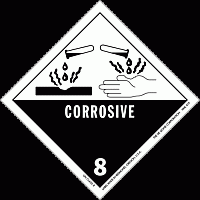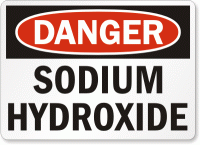handle lye solutions with the utmost caution…
© 2010 by KV5R — Rev. Nov. 24, 2010.
The author accepts no responsibility for your use or misuse of the information presented.
Shop for soap making supplies here.
Safety
Soap-making isn’t cooking—it’s chemistry. Some people have an irrational fear and even a hatred of all “chemicals,” a mind-set called chemophobia, caused by brainwashing and ignorance. Lye won’t hurt you if you handle it carefully. If you can handle a hot skillet or a boiling pot, you can handle lye, and it should be handled in the same manner and with the same care. Lye is a simple, natural chemical, not a complex synthetic “poison” like a pesticide. It’s a corrosive, and what means is that it reacts with many things, so don’t get any on you, and if you do, just wash it away! And don’t breathe the fumes.
 Handling a strong alkali is about as dangerous as handling car battery acid—it chemically burns skin, eats most metals, and makes dangerous fumes. It can cause permanent injuries. Use common sense, safety equipment, and ventilation. No phones ringing; no kids bumping into you; no distractions. Working in a sink of cold water, mix and pour with NO dribbling or splashing. Goggles and gloves are highly recommended, but normally your main concern will be avoiding the fumes. Either mix it outside (and risk carrying the hot caustic solution around), or open the kitchen sink window and put a fan in another window, blowing in, so that the sink window is blowing outward. Some people use the stove’s vent hood, but I’d rather work in a wet sink when mixing the solution. That way, any spills are already in the sink, and quickly diluted. I learned that trick from working 13 years in chemical plants, where we handled strong corrosives almost every day—safely.
Handling a strong alkali is about as dangerous as handling car battery acid—it chemically burns skin, eats most metals, and makes dangerous fumes. It can cause permanent injuries. Use common sense, safety equipment, and ventilation. No phones ringing; no kids bumping into you; no distractions. Working in a sink of cold water, mix and pour with NO dribbling or splashing. Goggles and gloves are highly recommended, but normally your main concern will be avoiding the fumes. Either mix it outside (and risk carrying the hot caustic solution around), or open the kitchen sink window and put a fan in another window, blowing in, so that the sink window is blowing outward. Some people use the stove’s vent hood, but I’d rather work in a wet sink when mixing the solution. That way, any spills are already in the sink, and quickly diluted. I learned that trick from working 13 years in chemical plants, where we handled strong corrosives almost every day—safely.
Fumes: My first batch was small, using only 3.3 ounces of lye in 1 cup water, and the fumes lasted just a few seconds. It was visible and easy to avoid, and the fan quickly took it out. No more dangerous than treating a clogged drain. If your caustic gets too hot and makes too many fumes, start with colder water next time.
Spills: #1, keep pets and people from the area; don’t track it! If you spill dry lye powder, collect it with a shop-vacuum, and get every last crystal. Do not touch it or add water to it. If you spill the wet solution, use rubber gloves and a sponge. Rinse and repeat several times. In any case, follow the MSDS.
Exposure: Again, follow the MSDS. Use safety equipment. If you feel a little sting on the hand or arm, just wash it immediately. If you splash a lot on you (like, you drop the caustic cup), immediately get in the shower, with clothes on, get soaked, then remove clothing. Wash for at least 15 minutes, per the MSDS. Eye contact is extremely serious. Hold eyes open and flush with lots of cool water. Time and concentration are your enemies. You have seconds—you don’t have time to panic or be indecisive. The faster you are soaked with water, the less damage will be done. People permanently injured by corrosives are those who got hysterical when they should have been getting wet! You can always declare an emergency later, if needed. But most of all, just don’t spill or splash it in the first place.
Scalds: Mix the caustic in the sink and leave it there until cool. The only thing worse than getting caustic on you is getting caustic on you that’s 170°F! The heat will scald, and the hot caustic will react much faster with skin. Hot-process soaping, rebatching, and melt & pour uses temperatures that can scald you. It’s not quite as hot as deep-frying, but handle it in the same manner. Use heavy gloves when molding hot soap.
Gases: Be aware that caustic and food sugars react and make carbon monoxide. Positive ventilation is essential if adding milk or honey to the mix.
Metals: Caustic reacts with most metals, producing hydrogen. Use only containers and tools made of stainless steel, plastic, porcelain glazed, or tempered glass. A good work surface is a large HDPE cutting board, placed over half the sink (see photos). Place a cuptowel under it so it won’t slide around.
Storage: Store your unused lye like you would any drain cleaner—properly marked, tightly capped, in the highest cabinet, if kids might get into it. Nowadays, well-hidden and/or under lock and key might be better…
Stick blender: Use care with the stick blender: (1) unplug right after using; (2) don’t set it down where the goop can get on anything (fresh soap still very caustic); and (3) don’t let the motor fall in the sink. And don’t bump the power button after lifting it out the pot, else you’ll fling sticky causticy mess everywhere in general.
Mental Preparation: Never handle dangerous substances when tired, stressed, or intoxicated. Soaping isn’t cooking—it’s chemistry—put your mind in chem-lab mode. Work carefully, with deliberate moves, like any skilled lab technician would. Plan your moves so you never find yourself at a loss for where to put down something with caustic or caustic-soap on it. Work in a sink or other large basin as much as possible. Keep the work area clean and organized. Control access to the work area. Don’t soap if you are terrified or paranoid of handling caustic, as this will impair your ability to safely handle it or properly respond to accidents.

